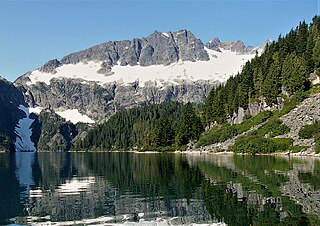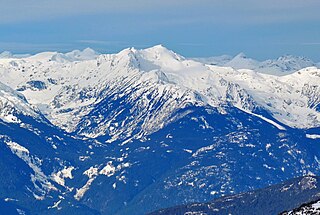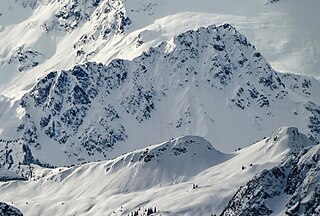
Mount Jimmy Jimmy is a 2,208-metre (7,244 ft) glaciated mountain located in the Coast Mountains in southwestern British Columbia, Canada. It is situated 32 kilometres (20 mi) northwest of Squamish, and 10 km (6 mi) northwest of Ossa Mountain, which is its nearest higher peak. Mt. Jimmy Jimmy is the highest point of the Tzoonie-Clowhom Divide. Precipitation runoff from the peak and meltwater from its immense glaciers drains into tributaries of the Squamish River and Clowhom River. The mountain was named for Chief Jimmy Jimmy, a leader of the Squamish Nation, who had traplines in the vicinity of the mountain and was a skilled paddler. The mountain's name was officially adopted on June 6, 1957, by the Geographical Names Board of Canada.

Lydia Mountain is a 2,100-metre (6,890-foot) summit located in the Tantalus Range, in Tantalus Provincial Park, in southwestern British Columbia, Canada. It is situated 14.5 km (9 mi) northwest of Squamish, and 5.46 km (3 mi) south-southeast of Mount Tantalus, which is the highest peak in the Tantalus Range. The nearest higher neighbor is The Red Tusk, 0.5 km (0 mi) to the west, and Mount Niobe lies 2.17 km (1 mi) to the east-southeast. Lake Lovely Water lies below the eastern slope of the peak and precipitation runoff from the peak drains east to the Squamish River, and west to the Clowhom River via Red Tusk Creek. Topographic relief is significant as Lydia Mountain rises 1,400 meters (4,600 feet) above Red Tusk Creek in approximately three kilometers (two miles). The mountain's name was officially adopted on June 6, 1957, by the Geographical Names Board of Canada. The mountain was named for mythic Lydia, of which Tantalus was a primordial ruler in Greek mythology. Several peaks in the Tantalus Range are named in association with Tantalus. The first ascent of Lydia Mountain was made in 1914 by Basil Darling and Allan Morkill.

Ipsoot Mountain is a 2,576-metre (8,451-foot) glaciated summit located in southwest British Columbia, Canada.

Antimony Mountain is a 2,668-metre (8,753-foot) mountain summit located in British Columbia, Canada.

Rhododendron Mountain is a 2,523-metre (8,278-foot) glaciated summit in British Columbia, Canada.

Cloudraker Mountain is a 2,385-metre (7,825-foot) glaciated summit in British Columbia, Canada.
Whitecap Mountain is a 2,918-metre (9,573-foot) summit in British Columbia, Canada.

Mount Sir Richard is a 2,681-metre (8,796-foot) glaciated summit in British Columbia, Canada.

In-SHUCK-ch Mountain is a 2,386-metre (7,828-foot) summit in British Columbia, Canada.

The Lecture Cutters are 2,524-metre (8,281-foot) mountain peaks in British Columbia, Canada.

Outlier Peak is a 2,422-metre (7,946-foot) mountain summit in British Columbia, Canada.

Nivalis Mountain is a 2,659-metre (8,724-foot) mountain summit in British Columbia, Canada.

Mount Neal is a 2,552-metre (8,373-foot) glaciated summit in British Columbia, Canada.

Carcajou Peak is a 2,239-metre (7,346-foot) mountain summit in British Columbia, Canada.

Mount Moe is a 2,664-metre (8,740-foot) glaciated summit in British Columbia, Canada.

Twin Goat Mountain is a 2,128-metre (6,982-foot) summit in British Columbia, Canada.

Icecap Peak is a 2,435-metre (7,989-foot) glaciated summit in British Columbia, Canada.

Mount Evans is a 2,250-metre (7,382-foot) glaciated summit in British Columbia, Canada.

Tzoonie Mountain is a 2,123-metre (6,965-foot) summit in British Columbia, Canada.

Mount Pitt is a 2,487-metre (8,159-foot) summit in British Columbia, Canada.























